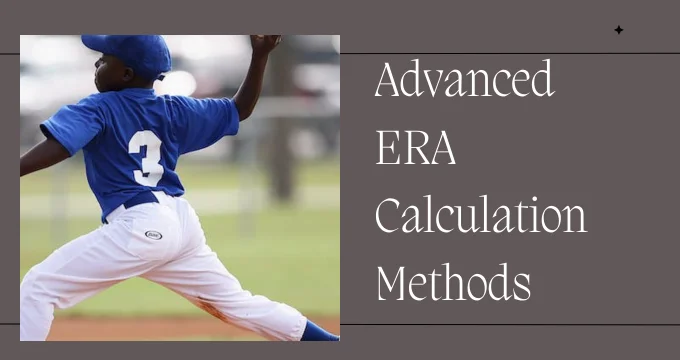Welcome to the realm of advanced ERA calculations! As an avid baseball enthusiast, you understand that baseball isn’t just a game, but a symphony of statistics. Mastering ERA (Earned Run Average) is like learning a key musical note, and our guide will help you play the stats like a virtuoso!
Delve into the meat of these calculations with our 5-step guide, meticulously crafted to transform your approach to baseball stats. We’re talking about an average, but this information is far from average. Get ready to elevate your game, eclipse your rivals, and stand out with your uniquely honed understanding of ERA calculations!
5 Step Guide to Advanced ERA Calculation Methods
Step 1: Grasping ERA Basic Concepts
Understanding ERA is fundamental to any serious baseball aficionado. ERA, or Earned Run Average, is a commonly used statistic in baseball that measures the average number of earned runs a pitcher allows per nine innings pitched.

To get a firm grip on ERA, one must understand the difference between earned runs and unearned runs. Earned runs are those that result directly from the actions of the batters and baserunners. In contrast, unearned runs occur due to the fielding mistakes or errors committed by the defensive team. An ERA calculation only considers earned runs, thus providing a measure of a pitcher’s skill that eliminates the variables beyond their control.
Success in baseball heavily relies on these statistics. The lower the ERA, the better the pitcher’s performance. For instance, an ERA of 2.00 implies that on average, a pitcher allows two earned runs per nine innings. With these facts, you can see that mastering ERA calculation isn’t just a numerical task, but a strategic game in itself. Prepare for a deep dive into ERA calculation methods in the next steps of our guide.
Step 2: Components of ERA Explained
Understanding the components of ERA is akin to unearthing the layers of a baseball puzzle. This statistical tool comprises three primary components: Earned Runs (ER), Innings Pitched (IP), and the conversion factor of 9, representing a full game in baseball.
Earned Runs (ER) form the base of the ERA pyramid. Any run that scores against a pitcher without the aid of an error or a passed ball is typically deemed an earned run. In 2020, the Major League Baseball (MLB) reported that the American League (AL) averaged 4.58 ER per game, while the National League (NL) had an average of 4.41 ER per game. The ER average provides a window into a pitcher’s effectiveness, painting a picture of their ability to stave off opposing hitters.
The next component, Innings Pitched (IP), is a measure of how long a pitcher has performed during matches. The importance of IP cannot be overstated, as it provides a method of evaluating the stamina and efficiency of a pitcher. According to MLB statistics, in 2020, the leader in IP was Shane Bieber of Cleveland Indians, with a total of 77.1 IP, illustrating his exceptional endurance and skill.
Lastly, we have the conversion factor of 9, which standardises ERA to a per-game metric. This allows for better comparisons across pitchers, making ERA an indispensable tool for evaluating performance in a sport where every run counts. It’s a fascinating journey to unravel the layers of ERA, but once you understand its construct, you’ll appreciate the depth and precision it brings to the beautiful game of baseball.
Step 3: The Process of Advanced ERA
The journey into the depths of advanced ERA calculations isn’t just about understanding the numbers, but also about grasping the strategy behind them. The first step in this process consists of tracking the earned runs (ER) and innings pitched (IP) for a specific pitcher over a set number of games or an entire season. For instance, let’s say a pitcher has allowed 15 earned runs during the 60 innings they have pitched.

In the next stage of the calculation, you divide the total earned runs by the total innings pitched. This gives you the earned run average per inning. If, for instance, the pitcher from our example has 15 earned runs and has pitched 60 innings, the calculation would be 15 ÷ 60 = 0.25. This number represents the average earned runs the pitcher allows per inning.
Lastly, to standardize the statistic to a per-game metric, you multiply this average by nine (the total number of innings in a standard baseball game). In our example, this would be 0.25 × 9 = 2.25. Thus, the pitcher’s ERA is 2.25, meaning on average, they allow 2.25 earned runs per full game they pitch. This detailed understanding of advanced ERA calculations can transform your baseball analytics approach, equipping you with the knowledge to make powerful predictions and strategic decisions.
Step 4: Nuances in ERA Calculation
Even though the process of ERA calculation appears straightforward, there exist several intricacies that can significantly impact a pitcher’s ERA. One such nuance involves how innings pitched (IP) are recorded. In baseball, an inning consists of three outs. Hence, if a pitcher records just one out before being replaced, they are credited with 0.1 innings.
Another subtle point to consider is that ERAs can sometimes be misleading due to the influence of small sample sizes. Let’s take an example of a pitcher who has an ERA of 3.00 after pitching nine innings and allowing three runs. If they were to allow a single run in their next inning, their ERA would increase to 3.60, a significant jump. This demonstrates how ERA can fluctuate dramatically over short periods, thus making it essential to consider the number of innings a pitcher has completed when assessing their ERA.
The home park of the pitcher also plays a crucial role in determining their ERA. Parks vary in their dimensions and climate, which can affect how far a hit ball travels and, consequently, the number of runs scored. To illustrate, consider Coors Field, home to the Colorado Rockies. This park is renowned for its high altitude, causing balls to travel further than in other parks. Consequently, pitchers at Coors Field tend to have higher ERAs. Therefore, when comparing pitchers’ ERAs, one must take into account the home park factor.
By being aware of these nuances in ERA calculation, you can further refine your understanding of this vital baseball statistic and make more informed judgments and predictions about players’ performances.
Step 5: Applying ERA in Game Strategy
ERA plays a decisive role in formulating game strategy in baseball. By assessing a pitcher’s ERA, managers can make informed decisions about when to start or replace a pitcher. For instance, a pitcher with a low ERA is likely to be more effective at preventing runs, making them a preferable choice to start a game or step in during high-stakes scenarios. According to a 2019 ESPN report, Jacob deGrom of the New York Mets recorded an impressive ERA of 2.43, highlighting his reliability as a starting pitcher.

In a tactical sense, managers might also use a pitcher’s ERA to foresee potential match outcomes. If a pitcher with a high ERA is due to face a team known for strong hitting, the manager might decide to opt for a different pitcher or develop a defensive strategy to minimize potential damage. For example, in the 2018 MLB season, American League batters boasted an average .248 Batting Average (BA). Thus, going up against a strong batting line-up with a high-ERA pitcher could potentially lead to an unfavorable outcome.
Moreover, ERA can be instrumental when managers are planning pitching rotations or determining which pitcher to use in specific scenarios. For instance, a strategy might be to use pitchers with lower ERAs in more critical games, thereby maximizing the chances of victory. A brilliant example of this strategy was demonstrated by the Houston Astros in the 2017 World Series, where they strategically used Justin Verlander, with an ERA of 2.21, in crucial games, a move that eventually led to their victory. By leveraging the insights provided by ERA, managers can devise robust game strategies and make data-driven decisions that could significantly influence the game’s outcome.
FAQ’s
How do advanced ERA methods surpass tradition?
Advanced ERA methods exceed traditional metrics by incorporating sophisticated algorithms, offering a nuanced evaluation of pitcher performance beyond simplistic measures.
Sophisticated algorithms enhance accuracy in ERA calculation.
Sophisticated algorithms in advanced ERA methods enhance accuracy by considering various statistical models, ensuring a precise assessment of pitcher effectiveness.
Factors like park effects in ERA calculation?
Advanced ERA methods incorporate factors like park effects, defensive performance, and situational context to provide a comprehensive evaluation, capturing the complexities of pitcher performance in diverse environments.
Historical impact on advanced ERA evolution?
Historical developments have influenced the evolution of advanced ERA methods, leading to refinements that enhance accuracy and relevance in evaluating pitcher performance over time.
Role of machine learning in ERA calculation?
Cutting-edge statistical techniques such as machine learning play a crucial role in advancing ERA calculation methods, providing deeper insights into pitcher performance through complex analytical models.
Tech impact on real-time ERA analysis?
Integration of real-time data from pitch tracking technologies revolutionizes pitcher performance analysis by enhancing the sophistication and responsiveness of advanced ERA calculation methods, ensuring accurate assessments in dynamic game situations.
Conclusion
In conclusion, ERA is a multifaceted statistic that provides valuable insights into a pitcher’s effectiveness in baseball. Its calculation takes into account many intricate aspects, such as innings pitched, the influence of small sample sizes, and the home park factor. ERA not only influences game strategies and pitching rotations but also plays a pivotal role in predicting match outcomes. Furthermore, advancements in ERA methods harness sophisticated algorithms and modern technologies like machine learning to enhance the accuracy, responsiveness, and comprehensiveness of this key performance indicator. As such, a nuanced understanding of ERA is crucial for anyone involved in or interested in baseball.
Related Posts
Contemporary Approaches to Calculate ERA
Cutting-Edge ERA Calculation Techniques
Innovative ERA Calculation Formulas
State-of-the-Art ERA Computation Methods
Latest ERA Calculation Algorithms
Revolutionary ERA Calculation Models
Modernized Methods for ERA Calculation
Current ERA Calculation Strategies
New–age ERA Calculation Formulations

